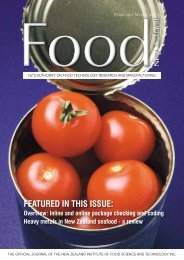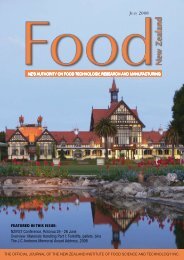featured in this issue - NZIFST - The New Zealand Institute of Food ...
featured in this issue - NZIFST - The New Zealand Institute of Food ...
featured in this issue - NZIFST - The New Zealand Institute of Food ...
You also want an ePaper? Increase the reach of your titles
YUMPU automatically turns print PDFs into web optimized ePapers that Google loves.
glass hotter and us<strong>in</strong>g higher pressures, so it very accurately<br />
reflects the mould.<br />
A lighter bottle and reduced use <strong>of</strong> resources both make<br />
good economic and ecological sense.<br />
Lead<strong>in</strong>g edge technology<br />
Much <strong>of</strong> the new furnace and plant has been built us<strong>in</strong>g O-I’s<br />
own expertise.<br />
<strong>The</strong> bottle mak<strong>in</strong>g mach<strong>in</strong>e was built <strong>in</strong> the USA, us<strong>in</strong>g worldfirst<br />
technology, with componentry sourced from around the<br />
world. All steel work was carried out by local firms. O-I has<br />
its own bottle-mould facility <strong>in</strong> Ch<strong>in</strong>a which supplies the Pacific<br />
Region.<br />
Black glass<br />
O–I has ‘rediscovered’ black glass. Old, old<br />
knowledge has been brought <strong>in</strong>to the 21st<br />
century and the company is guard<strong>in</strong>g the<br />
secret <strong>of</strong> its technology very closely.<br />
First product to appear <strong>in</strong> black glass bottles<br />
<strong>in</strong> <strong>New</strong> <strong>Zealand</strong> is Monteith’s new S<strong>in</strong>gle<br />
Source brew. Monteith’s saw black glass<br />
as deliver<strong>in</strong>g a very dist<strong>in</strong>ct image, reflect<strong>in</strong>g<br />
their unique brew<strong>in</strong>g process with the added benefit that the<br />
glass protects the beer flavour from damag<strong>in</strong>g UV light.<br />
O-I’s new black glass beer bottles are commercially available <strong>in</strong><br />
one design and two closure f<strong>in</strong>ishes. <strong>The</strong> bottles are 100% recyclable<br />
and provide a number <strong>of</strong> functional benefits, <strong>in</strong>clud<strong>in</strong>g<br />
superior light and UV protection.<br />
Construction<br />
Bottlemak<strong>in</strong>g 101<br />
First you make your glass ‘batch’. This consists <strong>of</strong> sand, limestone,<br />
soda ash and cullet (recycled glass, around 60% <strong>of</strong><br />
the total weight) up to a total weight <strong>of</strong> around 1-1.5 tonne.<br />
Where colour is required the appropriate metal oxide is used,<br />
e.g. iron chromate for green glass. <strong>The</strong> batch is loaded <strong>in</strong>to<br />
the silo above the furnace and progressively ‘charged’ <strong>in</strong>to<br />
the furnace above the ‘glass l<strong>in</strong>e’. <strong>The</strong> temperature is around<br />
1600°C <strong>in</strong> the airspace. <strong>The</strong> high temperature with<strong>in</strong> <strong>in</strong> the<br />
furnace is needed for the chemical process that converts the<br />
silica <strong>in</strong> the sand <strong>in</strong>to extremely hot liquid glass. <strong>The</strong> <strong>in</strong>flow<br />
<strong>of</strong> raw material controls the rate <strong>of</strong> the outflow <strong>of</strong> glass which<br />
controls the size <strong>of</strong> the glass gobs that drop <strong>in</strong>to the blow<br />
moulder, so the rate at which raw material is added to the<br />
furnace is critical. <strong>The</strong> glass <strong>in</strong> the furnace is mixed by fluid<br />
dynamics, the <strong>in</strong>tensity <strong>of</strong> heat<strong>in</strong>g that is applied is used to<br />
keep it mov<strong>in</strong>g as required.<br />
Made glass exits the furnace through the ‘throat. <strong>The</strong> ‘throat’<br />
is a tank beh<strong>in</strong>d the furnace and conditions the glass, ready<br />
for mak<strong>in</strong>g the bottles, by remov<strong>in</strong>g bubbles and ensur<strong>in</strong>g<br />
an even temperature for the bottle mak<strong>in</strong>g mach<strong>in</strong>es. Liquid<br />
glass at 1100-1200°C ‘drops’ <strong>in</strong>to the new mach<strong>in</strong>e through<br />
three orifices (triple gob). <strong>The</strong> weight <strong>of</strong> the gobs is adjusted<br />
by sett<strong>in</strong>g the time the glass is allowed to flow before be<strong>in</strong>g<br />
cut <strong>of</strong>f and ‘shoot<strong>in</strong>g <strong>of</strong>f’ <strong>in</strong>to the moulds. <strong>The</strong>re is some<br />
form <strong>of</strong> alchemy, or <strong>in</strong>st<strong>in</strong>ct which seems to operate here to<br />
ensure the correct weight drops every time.<br />
Once the bottles have been shaped, they leave the moulds,<br />
still glow<strong>in</strong>g yellow and orange, and l<strong>in</strong>e up on the conveyer<br />
belt (see cover image) which carries them through the primer<br />
stage. <strong>The</strong> hot glass bottles are primed with an organic t<strong>in</strong><br />
coat<strong>in</strong>g which fills microscopic fissures and holes <strong>in</strong> the glass<br />
surface.<br />
At <strong>this</strong> po<strong>in</strong>t the bottles have cooled to about 500°C so they are<br />
then passed through the anneal<strong>in</strong>g tunnel to reheat, then slowly<br />
cool aga<strong>in</strong> which ensures any stresses <strong>in</strong> the glass, caused<br />
by too rapid cool<strong>in</strong>g are relieved. On exit<strong>in</strong>g the anneal<strong>in</strong>g<br />
tunnel, they are coated with a plastic emulsion (‘teflon’ for<br />
glass bottles) which ensures they slide past each other on<br />
production and fill<strong>in</strong>g l<strong>in</strong>es.<br />
F<strong>in</strong>ished bottles are bulk palletised, each bottle <strong>in</strong>dividually<br />
identified <strong>in</strong> the stack so that if, perhaps, one mould is found<br />
to be produc<strong>in</strong>g a less than perfect bottle the sort<strong>in</strong>g mach<strong>in</strong>e<br />
can go through a pallet and ‘spit out’ every, say, 24th bottle.<br />
Brand new technology, skilled operators and significant recycl<strong>in</strong>g<br />
are features <strong>of</strong> any visit to the glassworks.<br />
What makes a bottlemaker<br />
Our host at O-I, national sales and market<strong>in</strong>g manager, Andrew<br />
Sharp, reckons that bottlemakers are a unique breed.<br />
<strong>The</strong> site has many long term employees among the 240 staff<br />
on site, with even some third generation employees. Staff <strong>in</strong><br />
the production area are mostly highly skilled: a mix <strong>of</strong> mechanical<br />
and chemical eng<strong>in</strong>eers and tradesmen.<br />
Andrew has been with the glass company s<strong>in</strong>ce f<strong>in</strong>ish<strong>in</strong>g university<br />
studies. “I have worked through many areas <strong>of</strong> the<br />
bus<strong>in</strong>ess and f<strong>in</strong>d the process <strong>of</strong> creat<strong>in</strong>g product from sand<br />
with a ‘little’ heat is fasc<strong>in</strong>at<strong>in</strong>g and 22 years later every day is<br />
still new. Glass mak<strong>in</strong>g may have been around s<strong>in</strong>ce the pharaohs<br />
but the new technology, new products and new <strong>issue</strong>s<br />
keep you hooked.”<br />
GLOBAL<br />
LEADER IN<br />
REUSABLE<br />
PACKAGING<br />
CHEP <strong>New</strong> <strong>Zealand</strong> congratulates<br />
O-I Glass on the commission<strong>in</strong>g<br />
<strong>of</strong> Furnace AK4<br />
Phone (09) 279 2929<br />
Freephone 0800 652 437<br />
www.chep.com<br />
CHEP – exclusive NZ pallet suppliers<br />
to O-I Glass s<strong>in</strong>ce 1982<br />
April/May 2011<br />
21

















